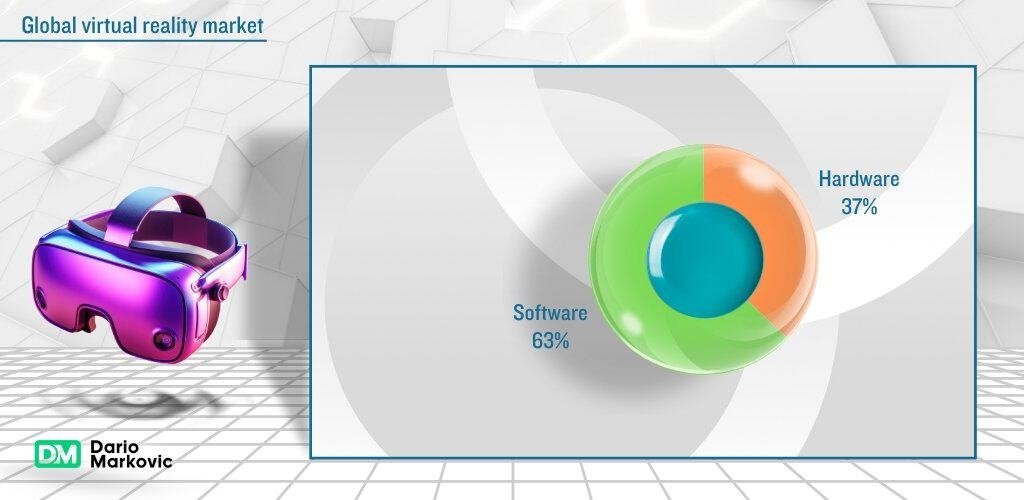The Rise of Virtual Reality Accessories
Virtual reality accessories have become an essential part of the VR experience, offering users a more immersive and interactive environment. As the VR market continues to expand, the demand for these accessories is also on the rise.
From headsets to gloves, these accessories are transforming the way we interact with virtual worlds.
3 Point Summary
Market Growth: The virtual reality accessories market is rapidly expanding, with projections indicating significant growth in the coming years. The global VR market size is expected to increase from less than $12 billion in 2022 to more than $22 billion by 2025.
Key Accessories: Essential virtual reality accessories include VR headsets, motion controllers, haptic gloves, VR treadmills, and VR suits. These accessories enhance the immersive experience and are crucial for both gaming and training applications.
Shopify Benefits: Selling virtual reality accessories on Shopify offers numerous advantages, such as a wide reach, user-friendly platform, customizable storefronts, secure payment options, and effective marketing tools. These features help attract a diverse customer base and increase sales.
Understanding the Market for Virtual Reality Accessories
The market for virtual reality accessories is growing rapidly. According to recent statistics, the global VR market size is projected to increase from less than $12 billion in 2022 to more than $22 billion by 2025.
This growth is driven by both the enterprise and consumer segments, with the VR gaming industry playing a significant role.
The annual growth rate of the VR market is estimated to be around 15%.
Key Virtual Reality Accessories
When it comes to virtual reality accessories, there are several key products that are essential for a complete VR experience. These include:
- VR Headsets: The most crucial accessory, providing the visual interface for the VR experience.
- Motion Controllers: Allow users to interact with the virtual environment through hand movements.
- Haptic Gloves: Provide tactile feedback, making the virtual experience more realistic.
- VR Treadmills: Enable users to walk or run in the virtual world, enhancing mobility.
- VR Suits: Offer full-body immersion, tracking movements and providing feedback.
The Role of Virtual Reality Accessories in Gaming
Gaming is one of the primary drivers of the virtual reality market. Virtual reality accessories have revolutionized the gaming experience, offering players a more immersive and interactive environment.
With the help of VR headsets, motion controllers, and haptic gloves, gamers can now feel as if they are truly part of the game. This has led to a surge in demand for VR accessories among gaming enthusiasts.
Virtual Reality Accessories in Education and Training
Beyond gaming, virtual reality accessories are also making a significant impact in education and training. VR headsets and motion controllers are being used to create realistic training simulations for various industries, including healthcare, aviation, and manufacturing.
These accessories provide a safe and controlled environment for trainees to practice and hone their skills.
Top-Selling Virtual Reality Headsets
Oculus Quest 2
- Widely regarded as a leading standalone headset, the Oculus Quest 2 offers wireless freedom, an extensive library of games, and intuitive controls. Its affordability and ease of use make it a bestseller.
PlayStation VR
- Designed for PlayStation consoles, this headset appeals to gamers looking for high-quality VR experiences with seamless integration into their existing setup. Titles like Resident Evil 7 and Astro Bot Rescue Mission contribute to its popularity.
Valve Index
- Known for its impressive display resolution and finger-tracking controllers, the Valve Index targets hardcore gamers. Its compatibility with SteamVR expands its appeal by providing access to a vast array of VR titles.
Essential Gaming Peripherals
Controllers and Grips
- Controllers like the Oculus Touch or HTC Vive’s wands are indispensable for interacting within VR environments. Enhanced grips improve comfort during prolonged sessions, ensuring better performance and reducing fatigue.
Headset Stands and Protective Covers
- Accessories such as stands keep headsets safe when not in use, while protective covers shield lenses from dust and scratches, prolonging the device’s lifespan.
Specialized Hardware for Immersive Experiences
- Foot controllers, motion tracking suits, and haptic feedback vests can elevate immersion levels significantly. These add-ons cater to users seeking deeper engagement in virtual worlds.
The expanding array of virtual reality accessories reflects their rising popularity among consumers. Retailers on platforms like Shopify can capitalize on this trend by offering a diverse catalog tailored to various user needs and preferences.
Statistics on the Virtual Reality Accessories Market
Market Growth
The global virtual reality (VR) market has been experiencing significant growth. In 2022, the market size was estimated at $59.96 billion and is expected to grow at a compound annual growth rate (CAGR) of 27.5% from 2023 to 2030. The VR gaming accessories market alone accrued $7.92 billion in 2021 and is predicted to reach $56.55 billion by 2030, registering a CAGR of 31.6% from 2022 to 2030.

Biggest Companies on the Market
Several companies dominate the virtual reality accessories market. Some of the top players include:
- Oculus VR LLC: Known for its Oculus Rift and Oculus Quest series.
- Lenovo Group Ltd: Offers a range of VR headsets and accessories.
- Samsung Electronics Co. Ltd.: Provides VR headsets like the Samsung Gear VR.
- Sony Corporation: Known for the PlayStation VR.
- Pico Interactive Inc.: Offers standalone VR headsets.
Revenue of Biggest Companies
- Oculus VR LLC: Oculus VR’s revenue was estimated at $2.3 billion in 2021.
- Sony Corporation: The PlayStation VR contributed significantly to Sony’s revenue, with the company reporting $25 billion in revenue from its gaming and network services segment in 2021.
- Samsung Electronics Co. Ltd.: Samsung’s VR segment is part of its broader electronics division, which reported $200 billion in revenue in 2021.
Best Selling Products and Their Revenue
Difference Between Cost of Manufacturing and Price of Selling
The cost of manufacturing VR accessories varies significantly based on the complexity and technology involved. For instance, the manufacturing cost of a high-end VR headset like the Oculus Quest 2 is estimated to be around $250, while it retails for approximately $300. This indicates a gross margin of around 20%.
Target Audience Demographics
The primary demographic for virtual reality accessories includes:
Market Segmentation
The virtual reality accessories market can be segmented based on:
Projections
The virtual reality market is projected to continue its rapid growth. By 2032, the market size is expected to reach $244.84 billion, exhibiting a CAGR of 28.6% during the forecast period from 2024 to 2032. The AR & VR market is projected to generate revenue of $40.4 billion in 2024, with an annual growth rate of 8.97% from 2024 to 2029.
These statistics highlight the immense potential and growth opportunities in the virtual reality accessories market, making it a lucrative segment for businesses and investors alike.
Benefits of Selling Virtual Reality Accessories on Shopify
Selling virtual reality accessories on Shopify offers several benefits:
- Wide Reach: Shopify provides access to a global audience, allowing sellers to reach customers from all over the world.
- User-Friendly Platform: Shopify’s platform is easy to use, making it simple for sellers to set up and manage their online store.
- Customizable Storefronts: Sellers can customize their storefronts to reflect their brand and attract customers.
- Secure Payment Options: Shopify offers secure payment options, ensuring that customers’ transactions are safe and reliable.
- Marketing Tools: Shopify provides various marketing tools to help sellers promote their products and increase sales.
Challenges in the Virtual Reality Accessories Market
While the virtual reality accessories market is growing, it also presents several challenges:
- High Competition: The market is highly competitive, with many players vying for a share of the market.
- Technological Advancements: Keeping up with the rapid pace of technological advancements can be challenging for sellers.
- Cost: The cost of producing and purchasing VR accessories can be high, which may deter some customers.
- Consumer Awareness: Educating consumers about the benefits and uses of VR accessories is crucial for market growth.
Strategies for Marketing Virtual Reality Accessories Effectively
To maximize the potential of Shopify for VR accessories sales, consider implementing the following strategies:
Targeted Advertising
- Utilize social media platforms such as Facebook and Instagram to run targeted ad campaigns aimed at VR enthusiasts.
- Google Ads can also be effective in capturing search traffic related to virtual reality accessories.
Content Marketing
- Create informative blog posts, how-to guides, and video tutorials that demonstrate the benefits and uses of various VR accessories.
- Collaborate with influencers in the tech and gaming industries to reach a broader audience.
Email Marketing
- Develop engaging email campaigns that highlight new product releases, special promotions, and exclusive discounts.
- Segment your email lists based on customer behavior and preferences to deliver personalized content.
Customer Reviews and Testimonials
- Encourage satisfied customers to leave reviews on your product pages. Positive feedback can significantly boost credibility and trust among potential buyers.
Bundling Products
- Offer bundles or packages that include multiple VR accessories at a discounted rate. This can increase average order value and provide customers with more comprehensive solutions.
By leveraging these strategies, sellers can effectively utilize Shopify’s robust platform to drive sales and grow their business in the thriving market of virtual reality accessories.
My Personal Experience with Virtual Reality Accessories
As a Shopify seller, I have found virtual reality accessories to be a promising niche. The demand for these accessories is growing, and they offer a unique and immersive experience for users.
By offering a range of VR accessories, I have been able to attract a diverse customer base and increase my sales.
The key to success in this market is staying updated with the latest trends and continuously improving the product offerings.
FAQ
Virtual reality accessories are devices and equipment that enhance the VR experience. These include VR headsets, motion controllers, haptic gloves, VR treadmills, and VR suits.
Virtual reality accessories are crucial for creating an immersive and interactive VR experience. They allow users to engage with virtual environments in a more realistic and tactile way.
The global VR market size was estimated at $59.96 billion in 2022 and is expected to grow at a compound annual growth rate (CAGR) of 27.5% from 2023 to 2030.
Some of the biggest companies in the VR accessories market include Oculus VR LLC, Lenovo Group Ltd, Samsung Electronics Co. Ltd., Sony Corporation, and Pico Interactive Inc.
Some of the best-selling VR accessories include the Oculus Quest 2, PlayStation VR, and Samsung Gear VR.
The cost of manufacturing VR accessories varies, but for example, the manufacturing cost of an Oculus Quest 2 is around $250, while it retails for approximately $300, indicating a gross margin of around 20%.
The primary demographic for VR accessories includes individuals aged 25 to 34, with a higher usage rate among those aged 30 to 34. The audience is predominantly male (57%) but also includes a significant female user base (43%).
The VR accessories market can be segmented based on product type (VR headsets, motion controllers, haptic gloves, VR treadmills, VR suits), application (gaming, education, healthcare, training, and simulation), and device type (head-mounted displays, VR simulators, VR glasses, treadmills, haptic gloves).
The VR market is projected to reach $244.84 billion by 2032, with a CAGR of 28.6% during the forecast period from 2024 to 2032. The AR & VR market is expected to generate revenue of $40.4 billion in 2024, with an annual growth rate of 8.97% from 2024 to 2029.
Selling VR accessories on Shopify offers benefits such as a wide reach, user-friendly platform, customizable storefronts, secure payment options, and effective marketing tools, helping sellers attract a diverse customer base and increase sales.



